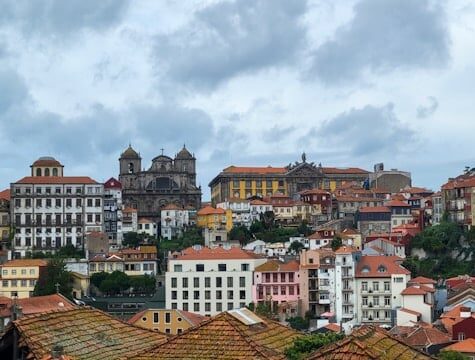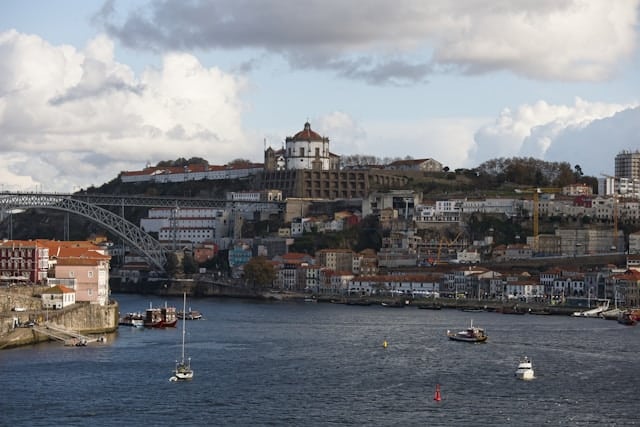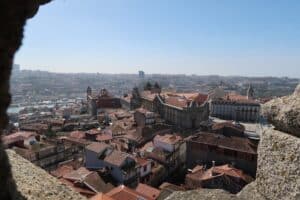While most people decide to start their Portugal journey in Lisbon, there are plenty of equally appealing places. A great example that might not immediately come to mind is in the southwest corner of Portugal, close to the Spanish border.
Living in Porto is unlike living in any other city on the Iberian Peninsula. While remaining authentically Portuguese, Porto proudly balances the artistic with the historic – together with the iconic Francesinha dish. Where Lisbon has a more cosmopolitan vibe, Porto is down-to-earth and residents are deeply proud of their city’s history and traditions.
In this article, we’ll take a look at what makes “The Undefeated City” more intimate than Lisbon, larger and busier than Coimbra, and more lush than the Algarve.
You’ll also find out more about:
Porto Quick Facts
Porto, the second biggest city in Portugal, is located in the north of Portugal. Less than two hours south of Spain, it is known for its Port wine production, rich history, and modern development. The city is safe and affordable and has stunning views of the Douro River, with the wine houses on the banks opposite the river.
Apart from being a UNESCO World Heritage site, Porto is home to prestigious educational institutions like the University of Porto. Expats can choose central neighborhoods like Ribeira District, which is more expensive and tourist-heavy, or more affordable areas like Vila Nova de Gaia across the river.
Porto Quick Facts | |
Population | 215,000 |
Climate | Mediterranean climate with mild, rainy winters and warm, dry summers |
Nearest Airport | Francisco Sá Carneiro Airport (Porto Airport) |
Beach Proximity | ~10 km (Matosinhos Beach) |
Ideal for | Expats, as well as families and retirees, are looking for a balance of tradition and modernity. |
International schools | Approximately 4 in Porto and the surrounding area. |
Why is everyone moving to Porto?
There are many reasons to live in Porto, and it’s not just about the excellent Port wine.
Affordable, high-quality living: Porto has an affordable environment with high-quality living, making rent, dining out, and transportation cheaper than other major cities in Europe.
Welcoming community: Serving a mix of artistic expression and historical wonder, Porto has a strong sense of community and openly welcomes anybody into the city.
Outstanding business location: Aside from Lisbon, Porto is the next biggest hub for doing business in the country. Many international businesses have chosen to settle down in this charming northern city.
The weather has character: Porto’s weather is mild and a little more moody than Lisbon’s. Summers are comfortably warm but not nearly as stifling as southern Portugal’s. While snow is extremely rare in winter, rain is common, making it cold and damp.
Is Porto safe?
Like much of Portugal, Porto is very safe, especially compared to other global cities of the same size. The Global Peace Index ranks Portugal as the 7th safest country globally, as major violent crimes are extremely rare.
However, you should always use caution and common sense. Petty crimes like pickpocketing do exist and are mostly targeted at tourists, mostly in crowded spots like São Bento Station, Ribeira, or on public transport. But with that said, Porto is totally safe to walk around at night or by yourself.
The 7 Best Neighborhoods in Porto
Porto has a variety of vibrant neighborhoods, each with its unique character and atmosphere. In this section of our article on living in Porto, we will explore each neighborhood to help you find the ideal spot in the city that suits your preferences.
1. Ribeira

It’s known for its striking architecture of centuries-old buildings painted in soft pastels or covered in traditional azulejos (tiles) and for its tight, winding streets that reflect the layout of a medieval city.
The neighborhood is visually stunning, making for great Instagram posts of the Dom Luís I Bridge, the Vila Nova de Gaia waterfront and the boats lined up along the river.
Ribeira is one of the most central locations in Porto, making it easy to access restaurants, museums, public transport, and most tourist attractions.
This area is ideal for short-term visitors, as you can walk almost anywhere in the city center from here, and the atmosphere is distinctly Portuguese.
However, Ribeira is busy year-round with tourists, which means it can be noisy during the day and into the evening, especially during peak season. Accommodation is often more expensive, and many of the apartments are older and smaller, sometimes lacking modern amenities.
2. Cedofeita
Cedofeita is home to Porto’s art district, blending artsy energy and residential calm with galleries, concept stores, and street murals tucked between traditional homes and cafés. The area is central but quieter than Ribeira, popular among students, creatives, and younger expats. Housing varies from newly renovated apartments to charming, older homes. It’s walkable and well connected by metro, offering a nice balance between local life and cultural buzz.
3. Foz do Douro
Foz do Douro is a highly desirable neighborhood in Porto, ideal for families. It offers modern homes with stunning ocean views and a long promenade for enjoying the scenery. The area features clean beaches, upscale dining, and a suburban atmosphere, making it appealing for those seeking tranquility and a high-end lifestyle. While it’s less connected by public transport, this distance adds to its charm. Foz is situated where the Douro River meets the Atlantic, providing the best of both beach and city living.
4. Vila Nova de Gaia

The two are connected by several bridges — most famously the Dom Luís I Bridge — and they function almost like twin cities. Gaia is best known for its port wine cellars, but there’s a lot more going on here than just tastings and tours.
Living in Gaia offers a calmer, more spacious alternative to Porto proper. Housing is often larger and slightly more affordable, especially the farther you go from the river. There’s a real mix of modern high-rises, older homes, and new-build developments.
Public transport links are solid, and the area has all the services you’d expect — schools, shopping malls, and public parks. Gaia also offers direct access to the coast, including beaches like Miramar and Senhor da Pedra, which are only 15–20 minutes away by train.
5. Paranhos
Paranhos is further north and known mainly for its connection to Porto’s universities and hospitals. It’s quieter and more residential, with a mix of student housing and family homes. The vibe is relaxed, with local cafés and markets rather than trendy bars. It’s not flashy, but it’s affordable, green, and well-connected by metro. Ideal for students, families, or anyone who wants space and stability.
6. Bonfim
Bonfim is east of the city center and has become one of Porto’s trendiest up-and-coming areas. It was once a working-class neighborhood but is now attracting young professionals and expats. There’s a growing number of co-working spaces, minimalist cafés, and converted warehouses. Rent here tends to be more affordable, and there’s a slightly edgier, more lived-in feel. It’s not as tourist-heavy, which makes it feel more grounded in daily life.
7. Boavista

This area doesn’t have the medieval charm of the old town, but it makes up for it with functionality, international schools, office towers, and modern residential buildings.
The neighborhood is a commercial and cultural hub. It’s home to the striking Casa da Música, a major concert venue, as well as several high-end hotels and shopping centers.
The area attracts professionals, business travelers, and families looking for a quieter, more organized living experience. There’s a sense of space and order here that you won’t find in Porto’s older quarters.
Boavista’s housing is typically more modern. You’ll find spacious apartments, often with elevators, balconies, and parking — rare luxuries in the city center.
Public transport is excellent, with several metro stations and bus routes crossing the area. While the vibe can be a bit formal or “corporate” in parts, there are also pockets of green space and residential calm, especially closer to the western end of the avenue.
How to Find Accomodation in Porto
One of the best things about buying or renting property is that Portugal’s policies are very flexible for foreigners, allowing you to easily buy or rent a property in Porto.
Renting in Porto
Renting in Porto is significantly lower than in Lisbon, with some estimates pegging it as much as 26 percent. A one-bedroom apartment in the city center ranges between €1,500 and €800 per month, while a similarly sized apartment outside the city center costs around €650 to €1,000. On average, a larger, three-bedroom apartment in the city center costs about €1,860 per month, while you can expect to pay around €1,364 per month outside the center.
Since Portugal is a relatively small country, you can use the same services in Porto as you would in Lisbon to find accommodation, like:
- Idealista
- Spot a Home
- CasaSAPO
- Imovirtual
Buying property in Porto
It is relatively easy for foreigners to buy property in Porto and its real estate market is significantly more affordable than Lisbon and other Western European cities. The city offers a variety of property types and price ranges, from modern apartments to luxurious homes, making it accessible to different budgets. The average price per square meter in the city center ranges from €3,000 to €5,241, while outside the city center, you can expect to pay around €2,300 per square meter.
However, some neighborhoods command a much higher price than others. For example, newly refurbished real estate in Ribeira can set you back in excess of €6,500 per square meter, while outside the city center, property in Boavista can easily reach €4,500 per square meter.
How to Live in Porto as an Expat
For EU Citizens
If you’re an EU citizen, relocating to Porto is a smooth process. As part of the European Union, you benefit from the freedom of movement within EU countries. To start your journey, simply register with local authorities to officially reside in Portugal.
For Non-EU Citizens
Portugal offers several immigration options for non-EU citizens looking to make Porto their home. The country provides a range of visas tailored to different needs, including Portugal dual citizenship options that are particularly appealing to many expats, such as UK citizens and Americans. Here’s a look at some of the most popular visa categories for non-EU citizens seeking residency in Porto:
Portugal Golden Visa Program
The Portugal Golden Visa program offers residency to investors who are contributing to Portugal’s economy. You can qualify by investing in sectors like art and culture or in Portugal Golden Visa investment funds.
D7 Visa Portugal
The Portugal D7 Visa is designed for financially independent individuals, including retirees, who have a passive income and wish to stay in Portugal permanently. To be eligible, you must demonstrate a minimum monthly income of €870, Portugal’s minimum wage. This visa provides an excellent pathway for those with steady passive income.
D3 Visa Portugal
The Portugal D3 Visa, or Highly Qualified Activity Permit, is aimed at skilled professionals who have secured employment or a self-employment contract with a Portuguese company. This visa is ideal for professionals and is designed to attract talent to Portugal’s workforce.
D2 Visa Portugal
The Portugal D2 Visa, also known as the Entrepreneur Visa, is designed for foreigners who wish to start or expand their business in Portugal. It’s suitable for entrepreneurs, freelancers, and independent service providers looking to invest in or launch a business within the country.
Digital Nomad Visa
The Portugal Digital Nomad Visa (D8 Visa) caters to remote working in Portugal. To qualify, you must prove a monthly income of at least €3,480, four times the Portuguese minimum wage. This visa is ideal for digital nomads looking for a base in Porto while working remotely.
Cost of Living in Porto
Living in Porto is generally more affordable, though costs depend on lifestyle. Average monthly expenses for a single person are around €800 to €1,000 without rent, and while dining out and transportation are inexpensive, imported goods may be costly.
Food
Food is relatively inexpensive, particularly if you buy locally. Of course, if you want products imported from other countries, they will be more expensive. Also, because of the climate in Portugal, you can find fresh fruits and vegetables. Given the country’s long coastline, fish is a staple of the diet, and good-quality meat is also easy to find.
Product | Average Price |
Milk (regular), (1 liter) | €0.64 |
Loaf of white bread (500g) | €1.13 |
Rice (white), (1kg) | €1.92 |
Eggs (regular) (12) | €1.92 |
Local cheese (1kg) | €8.04 |
Chicken filets (1kg) | €5.18 |
Beef round (1kg) | €9.52 |
Apples (1kg) | €1.78 |
Banana (1kg) | €1.26 |
Oranges (1kg) | €1.33 |
Tomato (1kg) | €1.59 |
Bottle of wine (mid-range) | €4.00 |
Domestic beer (0.5-liter bottle) | €1.05 |
Imported Beer (0.33-liter bottle) | €1.83 |
Eating out
The north of Portugal, including Porto, has some of the best gastronomy in the country. Many family-owned restaurants serve delicacies and very affordable meals. Porto is also home to many luxury and Michelin-starred restaurants if you are celebrating a special occasion.
An inexpensive meal in a restaurant costs €8. Porto’s gradually becoming more international has also given the city a wide choice of cuisines. As for the best francesinha dish in Porto, the Brasäo Aliados restaurant scores 4.6 out of 5 on Google with almost 14,000 reviews. Another great option is Café Santiago, which scored 4.4 on Google and had almost 1 5,000 reviews.
International Schools in Porto
For families considering moving and living in Porto, the city is an excellent choice. There are several international schools in Porto, providing a variety of curricula, ranging from British and French to the International Baccalaureate.
The Oporto British school, which can be found in Foz do Douro, is the oldest British school in Continental Europe and is considered one of the best. You also have CLIP Oporto International School, which provides an English National Curriculum, and the Lycée Francais International Porto and Deutsche Schule zu Porto, which provide French and German schooling, respectively.
As a legal resident of Porto, you can enroll your children in a public school for free. However, state schools require a lot of paperwork so you will need to plan in advance. Also, the language barrier could be an issue, but if your child is of a younger age it could be a good option so that they can soak up the language from a young age.
Top 5 international schools in Porto
- CLIP – The Oporto International School
- Lycée Francais International de Porto
- Deutsche Schule zu Porto
- Oporto British School
- CJD International School
Navigating Public Transport in Porto

Metro: Porto’s metro system is efficient and well-connected throughout the city and its suburbs. It links major neighborhoods, shopping districts, and the airport, making it one of the most convenient ways to travel around the city.
Tram: Porto still operates a few traditional wooden trams, primarily along the riverfront and through the city’s historic areas. While they are more of a tourist attraction than a practical mode of transport, they provide a scenic and nostalgic journey.
Bus: STCP operates the city’s bus network, which covers areas that the metro doesn’t reach. Buses are frequent and reliable, though they can be slower during rush hour due to road traffic.
Taxi: Taxis are widely available throughout Porto and are metered, regulated, and generally reliable. They’re more expensive than public transport but useful for short rides, especially late at night when other options are limited.
Trains: The national rail network connects Porto with nearby cities such as Braga, Guimarães, and Aveiro. These trains are ideal for day trips and regional commuting, with departures from stations like São Bento and Campanhã.
Healthcare in Porto
You can access public healthcare throughout Portugal, including Porto, through Portugal’s National Health Service, the SNS. When certain treatments are not covered, private health insurance is an option, typically costing between €400 and €1,000 per year, depending on coverage and medical needs.
The Euro Health Consumer Index ranked Portugal’s healthcare system as the 13th best in Europe, higher than the UK, Spain, Italy, and Ireland. Portuguese healthcare scored the highest in terms of patient rights and information, waiting times, accessibility, and overall health outcomes.
Porto has several private and public hospitals, healthcare facilities, and pharmacies.
Pros and Cons of Living in Porto
While there are certainly pros and cons to living in Portugal, living in Porto is an excellent choice. The city provides all the benefits of living in a lively, happening, and international environment while having its unique, historic charm and relaxed pace of life. Retirees, families, or digital nomads who are looking for a fresh beginning should definitely consider moving to Porto.
Advantages
- Affordable cost of living in a great European city
- Good climate
- A thriving expat community
- Buzzing nightlife and social scene
- You are very close to excellent beaches
- Good business opportunities
- Very good restaurants
Cons
- Cobbled streets can be difficult to get by
- The bureaucratic process can be slow
- Tourism can make the city feel congested in summer, although this is not nearly as much of a problem as in Lisbon
- No central heating in some properties
Things to do in Porto
There are several exciting attractions and things to do in Porto throughout the year. Here are some of the highlights that you can look forward to.
Visit Livraria Lello
Often called one of the most beautiful bookstores in the world, Livraria Lello is a Neo-Gothic gem with a sweeping staircase, stained glass ceiling, and carved wood interiors.
It’s believed to have inspired parts of J.K. Rowling’s early Harry Potter imagery. Entrance now requires a ticket, but it’s redeemable against a book purchase.
Tour the port wine cellars in Vila Nova de Gaia
Just across the river, Gaia is home to the city’s famous port wine lodges. You can tour historic cellars like Sandeman, Graham’s, or Cálem, learning about the aging process and tasting several varieties. Each lodge has its own character — some are sleek and modern, others old-world and intimate. Tasting sessions often include small bites or chocolate pairings.
Climb Clérigos Tower
The Clérigos Tower is one of Porto’s most recognizable landmarks. Climb the 225 steps to the top for panoramic views over the city’s red rooftops and the river. Attached to the tower is a baroque church with ornate interiors that’s also worth a visit. It’s a great photo spot if you don’t mind a bit of a workout.
Visit the São Bento Train Station
Even if you’re not catching a train, São Bento Station is worth stepping inside. Its entrance hall is lined with over 20,000 blue-and-white azulejo tiles, depicting key moments from Portuguese history. The detail is impressive and entirely hand-painted. It’s one of the most beautiful transit hubs in Europe, and it’s free to enter.
Why choose Global Citizen Solutions for your Immigration Visa?
GLOBAL APPROACH BY LOCAL EXPERTS
- GCS has offices located across Portugal.
- Members of the US-Portugal and UK-Portugal Chambers of Commerce in Portugal, and the Investment Migration Council (IMC).
- Our expert team can help you throughout your journey to secure your Visa.
100% APPROVAL RATE
- Our successful track record in applications provides reassurance to applicants.
- We have helped clients from more than 35 countries secure residency in Portugal.
ALL-ENCOMPASSING SOLUTION
- With a single channel of communication, our approach ensures that you have complete clarity on your application.
- Our BeGlobal® Onboarding System allows for a total flow of information.
TRANSPARENCY AND PRIVACY
- Our pricing is clear and detailed, you will not face any hidden costs.
- All data is stored within a GDPR-compliant database on a secure SSL-encrypted server.
Frequently Asked Questions About Living in Porto
Is Porto a good place to live?
Porto is a good place to live due to its low cost of living, high safety rating, and strong cultural identity. The city offers affordable housing, mild climate, and a vibrant food and wine scene. Many expats also appreciate its walkability and access to healthcare and public transportation.
What is the cost of living in Porto?
The cost of living in Porto is approximately €1,200 to €1,600 per month for a single person, including rent. Rent for a one-bedroom apartment in the city center averages €800, while groceries, transportation, and utilities are relatively affordable compared to other Western European cities.
Is living in Porto expensive?
The cost of living in Porto has increased in recent years but remains a very affordable city when compared with other western European cities.
Is Porto safe to live in?
Porto is a safe city to live in, with low crime rates and a strong police presence. Violent crime is rare, and most incidents involve petty theft in tourist areas. Residents report feeling secure walking at night, and Portugal consistently ranks among the safest countries in Europe.
What are the best neighborhoods to live in Porto?
The best neighborhoods to live in Porto include Foz do Douro, Boavista, Cedofeita, and Ribeira. Foz offers coastal views and luxury housing. Boavista is modern and family-friendly. Cedofeita attracts artists and students. Ribeira, while touristy, provides historic charm and riverfront living.
What are the pros and cons of living in Porto?
Pros of living in Porto include affordable cost of living, mild climate, safety, and vibrant culture. Cons include limited job opportunities in some sectors, slower bureaucracy, and hilly terrain. While Porto offers quality of life and charm, it may lack the economic dynamism of larger cities.
Is Porto a good city for expats?
Porto is a good city for expats due to its affordable lifestyle, welcoming locals, and high quality of life. English is widely spoken in tourist and expat areas, and the city offers accessible healthcare, reliable public transport, and a strong international community.



